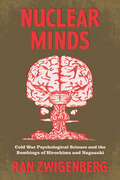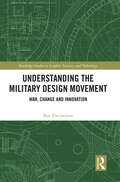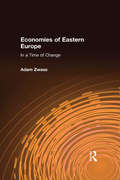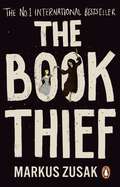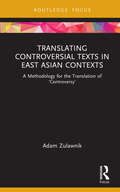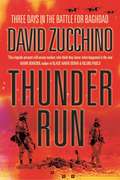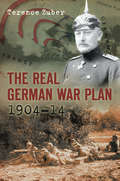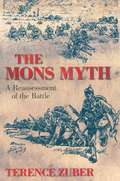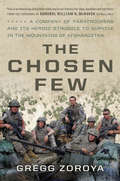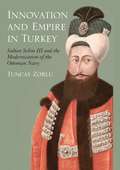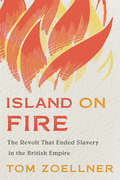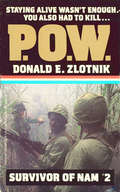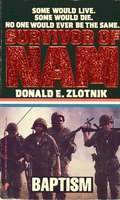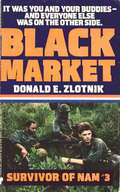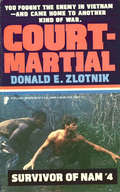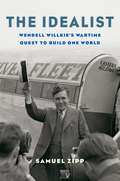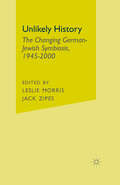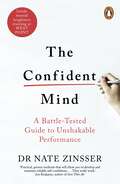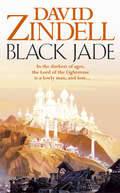- Table View
- List View
Nuclear Minds: Cold War Psychological Science and the Bombings of Hiroshima and Nagasaki
by Ran ZwigenbergHow researchers understood the atomic bomb’s effects on the human psyche before the recognition of Post-Traumatic Stress Disorder. In 1945, researchers on a mission to Hiroshima with the United States Strategic Bombing Survey canvassed survivors of the nuclear attack. This marked the beginning of global efforts—by psychiatrists, psychologists, and other social scientists—to tackle the complex ways in which human minds were affected by the advent of the nuclear age. A trans-Pacific research network emerged that produced massive amounts of data about the dropping of the bomb and subsequent nuclear tests in and around the Pacific rim. Ran Zwigenberg traces these efforts and the ways they were interpreted differently across communities of researchers and victims. He explores how the bomb’s psychological impact on survivors was understood before we had the concept of post-traumatic stress disorder. In fact, psychological and psychiatric research on Hiroshima and Nagasaki rarely referred to trauma or similar categories. Instead, institutional and political constraints—most notably the psychological sciences’ entanglement with Cold War science—led researchers to concentrate on short-term damage and somatic reactions or even, in some cases, on denial of victims’ suffering. As a result, very few doctors tried to ameliorate suffering. But, Zwigenberg argues, it was not only that doctors “failed” to issue the right diagnosis; the victims’ experiences also did not necessarily conform to our contemporary expectations. As he shows, the category of trauma should not be used uncritically in a non-Western context. Consequently, this book sets out, first, to understand the historical, cultural, and scientific constraints in which researchers and victims were acting and, second, to explore how suffering was understood in different cultural contexts before PTSD was a category of analysis.
Nuclear Minds: Cold War Psychological Science and the Bombings of Hiroshima and Nagasaki
by Ran ZwigenbergHow researchers understood the atomic bomb’s effects on the human psyche before the recognition of Post-Traumatic Stress Disorder. In 1945, researchers on a mission to Hiroshima with the United States Strategic Bombing Survey canvassed survivors of the nuclear attack. This marked the beginning of global efforts—by psychiatrists, psychologists, and other social scientists—to tackle the complex ways in which human minds were affected by the advent of the nuclear age. A trans-Pacific research network emerged that produced massive amounts of data about the dropping of the bomb and subsequent nuclear tests in and around the Pacific rim. Ran Zwigenberg traces these efforts and the ways they were interpreted differently across communities of researchers and victims. He explores how the bomb’s psychological impact on survivors was understood before we had the concept of post-traumatic stress disorder. In fact, psychological and psychiatric research on Hiroshima and Nagasaki rarely referred to trauma or similar categories. Instead, institutional and political constraints—most notably the psychological sciences’ entanglement with Cold War science—led researchers to concentrate on short-term damage and somatic reactions or even, in some cases, on denial of victims’ suffering. As a result, very few doctors tried to ameliorate suffering. But, Zwigenberg argues, it was not only that doctors “failed” to issue the right diagnosis; the victims’ experiences also did not necessarily conform to our contemporary expectations. As he shows, the category of trauma should not be used uncritically in a non-Western context. Consequently, this book sets out, first, to understand the historical, cultural, and scientific constraints in which researchers and victims were acting and, second, to explore how suffering was understood in different cultural contexts before PTSD was a category of analysis.
Understanding the Military Design Movement: War, Change and Innovation (Routledge Studies in Conflict, Security and Technology)
by Ben ZweibelsonThis book explains the history and development of the military design movement, featuring case studies from key modern militaries. Written by a practitioner, the work shows how modern militaries think and arrange actions in time and space for security affairs, and why designers are disrupting, challenging, and reconceptualizing everything previously upheld as sacred on the battlefield. It is the first book to thoroughly explain what military design is, where it came from, and how it works at deep, philosophically grounded levels, and why it is potentially the most controversial development in generations of war fighters. The work explains the tangled origins of commercial design and that of designing modern warfare, the rise of various design movements, and how today’s military forces largely hold to a Newtonian stylization built upon mimicry of natural science infused with earlier medieval and religious inspirations. Why does our species conceptualize war as such, and how do military institutions erect barriers that become so powerful that efforts to design further innovation require entirely novel constructs outside the orthodoxy? The book explains design stories from the Israel Defense Force, the US Army, the US Marine Corps, the Canadian Armed Forces, and the Australian Defence Force for the first time, and includes the theory, doctrine, organizational culture, and key actors involved. Ultimately, this book is about how small communities of practice are challenging the foundations of modern defence thinking. This book will be of much interest to students of military and strategic studies, defence studies, and security studies, as well as design educators and military professionals.
Understanding the Military Design Movement: War, Change and Innovation (Routledge Studies in Conflict, Security and Technology)
by Ben ZweibelsonThis book explains the history and development of the military design movement, featuring case studies from key modern militaries. Written by a practitioner, the work shows how modern militaries think and arrange actions in time and space for security affairs, and why designers are disrupting, challenging, and reconceptualizing everything previously upheld as sacred on the battlefield. It is the first book to thoroughly explain what military design is, where it came from, and how it works at deep, philosophically grounded levels, and why it is potentially the most controversial development in generations of war fighters. The work explains the tangled origins of commercial design and that of designing modern warfare, the rise of various design movements, and how today’s military forces largely hold to a Newtonian stylization built upon mimicry of natural science infused with earlier medieval and religious inspirations. Why does our species conceptualize war as such, and how do military institutions erect barriers that become so powerful that efforts to design further innovation require entirely novel constructs outside the orthodoxy? The book explains design stories from the Israel Defense Force, the US Army, the US Marine Corps, the Canadian Armed Forces, and the Australian Defence Force for the first time, and includes the theory, doctrine, organizational culture, and key actors involved. Ultimately, this book is about how small communities of practice are challenging the foundations of modern defence thinking. This book will be of much interest to students of military and strategic studies, defence studies, and security studies, as well as design educators and military professionals.
Economies of Eastern Europe in a Time of Change
by Adam ZwassThe development and use of the atomic bombs at Hiroshima and Nagasaki number among the formative national experiences for both Japanese and Americans as well as for 20th-century Japan-US relations. This volume explores the way in which the bomb has shaped the self-image of both peoples.
Economies of Eastern Europe in a Time of Change: In A Time Of Change
by Adam ZwassThe development and use of the atomic bombs at Hiroshima and Nagasaki number among the formative national experiences for both Japanese and Americans as well as for 20th-century Japan-US relations. This volume explores the way in which the bomb has shaped the self-image of both peoples.
The Book Thief: The life-affirming number one international bestseller
by Markus ZusakThis new edition features exclusive early chapter from Markus Zusak's brand new literary novel BRIDGE OF CLAY, out this October 2018.The New York Times and Sunday Times bestseller'A novel of breathtaking scope' Guardian1939. Nazi Germany. The country is holding its breath. Death has never been busier.Liesel, a nine-year-old girl, is living with a foster family on Himmel Street. Her parents have been taken away to a concentration camp. Liesel steals books. This is her story and the story of the inhabitants of her street when the bombs begin to fall.SOME IMPORTANT INFORMATION - THIS NOVEL IS NARRATED BY DEATH
Translating Controversial Texts in East Asian Contexts: A Methodology for the Translation of ‘Controversy’ (Routledge Advances in Translation and Interpreting Studies)
by Adam ZulawnikZulawnik focuses on the broad concept of ‘controversy’ and issues pertaining to the translation of politically and historically controversial texts in East Asia. The research methodology is exemplified through a case study in the form of the author’s translation of the best-selling Japanese graphic novel (manga) Manga Kenkanryū (Hate Hallyu: The Comic) by Sharin Yamano (2005), a work that has been problematised as an attack on South Korean culture and the Korean Wave. Issues analysed and discussed in the research include translation risk, ethics, a detailed methodology for the translation of so-called controversial texts exemplified through numerous thematically divided examples from the translation of the chosen Japanese text, as well as examples from a Korean language equivalent (Manhwa Hyeomillyu – Hate Japanese Wave), and definition and contextualisation of the concept of ‘controversy’. There has been limited research in the field of translation studies, which seeks to exemplify potential pragmatic approaches for the translation of politically-charged texts, particularly in multi-modal texts such as the graphic novel. It is hoped that Zulawnik’s research will serve both as a valuable source when examining South Korea–Japan relations and a theoretical and methodological base for further research and the development of an online augmented translation space with devices specifically suited for the translation of multi-modal texts such as – but not limited to – graphic novels and visual encyclopaedias.
Translating Controversial Texts in East Asian Contexts: A Methodology for the Translation of ‘Controversy’ (Routledge Advances in Translation and Interpreting Studies)
by Adam ZulawnikZulawnik focuses on the broad concept of ‘controversy’ and issues pertaining to the translation of politically and historically controversial texts in East Asia. The research methodology is exemplified through a case study in the form of the author’s translation of the best-selling Japanese graphic novel (manga) Manga Kenkanryū (Hate Hallyu: The Comic) by Sharin Yamano (2005), a work that has been problematised as an attack on South Korean culture and the Korean Wave. Issues analysed and discussed in the research include translation risk, ethics, a detailed methodology for the translation of so-called controversial texts exemplified through numerous thematically divided examples from the translation of the chosen Japanese text, as well as examples from a Korean language equivalent (Manhwa Hyeomillyu – Hate Japanese Wave), and definition and contextualisation of the concept of ‘controversy’. There has been limited research in the field of translation studies, which seeks to exemplify potential pragmatic approaches for the translation of politically-charged texts, particularly in multi-modal texts such as the graphic novel. It is hoped that Zulawnik’s research will serve both as a valuable source when examining South Korea–Japan relations and a theoretical and methodological base for further research and the development of an online augmented translation space with devices specifically suited for the translation of multi-modal texts such as – but not limited to – graphic novels and visual encyclopaedias.
Thunder Run: The Armored Strike to Capture Baghdad
by David ZucchinoThunder Run is the story of how, with fewer than a thousand men, and facing dug-in Iraqi forces, the Second ('Tusker') Brigade of the Third Infantry Division punched a hole through the heart of Baghdad with a high-speed charge to Saddam Hussein's Presidential Palace and Republican Guard headquarters.The product of dozens of interviews with commanders and men from the Second Brigade, it is more than just a book about a single battle. It is a riveting account of how soldiers respond under fire and and how human frailties are magnified in a war zone. Many people believe that Baghdad was taken with a minimum of effort. But for the Tusker Brigade it was a cruel and terrifying three days of urban warfare. Thunder Run tells the inside story of one of the most brutal and decisive battles in combat history and the biggest armoured battle involving American troops since the Vietnam War. It is an unputdownable, unforgettable first-hand account of how a single armoured brigade of fewer than a thousand men captured an Arab capital defended by one of the world's largest armies.
The Real German War Plan, 1904-14: 1904-14
by Terernce ZuberThe Real German War Plan, 1904-14 fundamentally changes our understanding of German military planning before the First World War. On the basis of newly discovered or long-neglected documents in German military archives, this book gives the first description of Schlieffen's war plans in 1904 and 1905 and Moltke's plans from 1906 to 1914. It explodes unfounded myths concerning German war planning, gives the first appraisal of the actual military and political factors that influenced it, shows that there never was a 'Schlieffen Plan' and reveals Moltke's strategy for a war against Russia from 1909 to 1912. Tracing the decline in the German military position and the recognition by 1913 that Germany would be forced to fight outnumbered on both the eastern and western fronts, it is an essential read for anyone with an interest in the First World War.
The Mons Myth: A Reassessment of the Battle
by Terence ZuberConventional histories of the Battles of Mons and Le Cateau describe how, although the British were massively outnumbered, precise and rapid rifle fire mowed down rows of German troops: the staggering casualties inflicted made both British victories, and set the stage for the Battle of the Marne. But neither encounter has ever been described in English from the German point of view. Using German tactics manuals and regimental histories, Terence Zuber re-examines the battles at Mons and Le Cateau, subjecting British tactics to a critique that goes beyond admiration for rapid rifle fire and presenting new and startling perspectives, showing how the Germans employed a high degree of tactical sophistication in conducting combined-arms operations. The odds were, in fact, even, and German casualties never reached the levels described in the standard histories. 'The Mons Myth' is the first history of these battles to take this approach in ninety years, and completely changes our understanding of what actually happened.
The Chosen Few: A Company of Paratroopers and Its Heroic Struggle to Survive in the Mountains of Afghanistan
by Gregg ZoroyaThe never-before-told story of one of the most decorated units in the war in Afghanistan and its fifteen-month ordeal that culminated in the 2008 Battle of Wanat, the war's deadliestA single company of US paratroopers--calling themselves the "Chosen Few"--arrived in eastern Afghanistan in late 2007 hoping to win the hearts and minds of the remote mountain people and extend the Afghan government's reach into this wilderness. Instead, they spent the next fifteen months in a desperate struggle, living under almost continuous attack, forced into a slow and grinding withdrawal, and always outnumbered by Taliban fighters descending on them from all sides.Month after month, rocket-propelled grenades, rockets, and machine-gun fire poured down on the isolated and exposed paratroopers as America's focus and military resources shifted to Iraq. Just weeks before the paratroopers were to go home, they faced their last--and toughest--fight. Near the village of Wanat in Nuristan province, an estimated three hundred enemy fighters surrounded about fifty of the Chosen Few and others defending a partially finished combat base. Nine died and more than two dozen were wounded that day in July 2008, making it arguably the bloodiest battle of the war in Afghanistan.The Chosen Few would return home tempered by war. Two among them would receive the Medal of Honor. All of them would be forever changed.
Innovation and Empire in Turkey: Sultan Selim III and the Modernisation of the Ottoman Navy
by Tuncay ZorluOttoman naval technology underwent a transformation under the rule of Sultan Selim III. New types of sailing warships such as two- and three-decked galleons, frigates and corvettes began to dominate the Ottoman fleet, rendering the galley-type oared ships obsolete. This period saw technological innovations such as the adoption of the systematic copper sheathing of the hulls and bottoms of Ottoman warships from 1792-93 onwards and the construction of the first dry dock in the Golden Horn.The changing face of the Ottoman Navy was facilitated by the influence of the British, Swedish and French in modernising both the shipbuilding sector and the conduct of naval warfare. Through such measures as training Ottoman shipbuilders, heavy reliance on help from foreign powers gave way to a new trajectory of modernization. Using this evidence Zorlu argues that although the Ottoman Empire was a major and modern independent power in this period, some technological dependence on Europe remained.
Innovation and Empire in Turkey: Sultan Selim III and the Modernisation of the Ottoman Navy (Library Of Ottoman Studies)
by Tuncay ZorluOttoman naval technology underwent a transformation under the rule of Sultan Selim III. New types of sailing warships such as two- and three-decked galleons, frigates and corvettes began to dominate the Ottoman fleet, rendering the galley-type oared ships obsolete. This period saw technological innovations such as the adoption of the systematic copper sheathing of the hulls and bottoms of Ottoman warships from 1792-93 onwards and the construction of the first dry dock in the Golden Horn. The changing face of the Ottoman Navy was facilitated by the influence of the British, Swedish and French in modernising both the shipbuilding sector and the conduct of naval warfare. Through such measures as training Ottoman shipbuilders, heavy reliance on help from foreign powers gave way to a new trajectory of modernization. Using this evidence Zorlu argues that although the Ottoman Empire was a major and modern independent power in this period, some technological dependence on Europe remained.'A valuable and well researched study… Zorlu ably surveys and analyses the developments which took place in Ottoman shipbuilding technology in the late eighteenth and early nineteenth centuries.' - Colin Heywood, University of Hull
Island on Fire: The Revolt That Ended Slavery in the British Empire
by Tom ZoellnerFrom a New York Times bestselling author, a gripping account of the slave rebellion that led to the abolition of slavery in the British Empire. For five horrific weeks after Christmas in 1831, Jamaica was convulsed by an uprising of its enslaved people. What started as a peaceful labor strike quickly turned into a full-blown revolt, leaving hundreds of plantation houses in smoking ruins. By the time British troops had put down the rebels, more than a thousand Jamaicans lay dead from summary executions and extrajudicial murder. While the rebels lost their military gamble, their sacrifice accelerated the larger struggle for freedom in the British Atlantic. The daring and suffering of the Jamaicans galvanized public opinion throughout the empire, triggering a decisive turn against slavery. For centuries bondage had fed Britain’s appetite for sugar. Within two years of the Christmas rebellion, slavery was formally abolished. Island on Fire is a dramatic day-by-day account of this transformative uprising. A skillful storyteller, Tom Zoellner goes back to the primary sources to tell the intimate story of the men and women who rose up and tasted liberty for a few brief weeks. He provides the first full portrait of the rebellion's enigmatic leader, Samuel Sharpe, and gives us a poignant glimpse of the struggles and dreams of the many Jamaicans who died for liberty.
Survivor of Nam: P. O. W. (Survivor of Nam #2)
by Donald E. ZlotnikThe second exciting book in this authentic series about Vietnam involves a 17-year-old corporal who is imprisoned by the Viet Cong and must endure the horrors of his capture until the U.S. Special Forces can rescue him. A super-heroic series, focusing on the grim realities of war.
Survivor of Nam: Baptism - Book #1 (Survivor of Nam #1)
by Donald E. ZlotnikPrivate David Woods, newly arrived in Vietnam, faces his first bloody firefight and a deadly mission into Laos. Book 1 of Survivor of Nam.
Survivor of Nam: Black Market - Book #3 (Survivor of Nam #3)
by Donald E. ZlotnikBook 3 of this exciting Vietnam adventure series involves the military Black Market, where everything is for sale: contraband military supplies, drugs, booze, and even women. Now the time has come for the payoffs to stop and this chapter of the Black Market to be closed down for good.
Survivor of Nam: Court Martial - Book #4 (Survivor of Nam #4)
by Donald E. ZlotnikYou fought the enemy in Vietnam--and came home to another kind of war. Book 4 of Survivor of Nam by Donald E. Zlotnik.
The Idealist: Wendell Willkie’s Wartime Quest to Build One World
by Samuel Zipp“The Idealist is a powerful book, gorgeously written and consistently insightful. Samuel Zipp uses the 1942 world tour of Wendell Willkie to examine American attitudes toward internationalism, decolonization, and race in the febrile atmosphere of the world’s first truly global conflict.” —Andrew Preston, author of Sword of the Spirit, Shield of Faith A dramatic account of the plane journey undertaken by businessman-turned-maverick-internationalist Wendell Willkie to rally US allies to the war effort. Willkie’s tour of a planet shrunk by aviation and war inspired him to challenge Americans to fight a rising tide of nationalism at home. In August 1942, as the threat of fascism swept the world, a charismatic Republican presidential contender boarded the Gulliver at Mitchel Airfield for a seven-week journey around the world. Wendell Willkie covered 31,000 miles as President Roosevelt’s unofficial envoy. He visited the battlefront in North Africa with General Montgomery, debated a frosty de Gaulle in Beirut, almost failed to deliver a letter to Stalin in Moscow, and allowed himself to be seduced by Chiang Kai-shek in China. Through it all, he was struck by the insistent demands for freedom across the world. In One World, the runaway bestseller he published on his return, Willkie challenged Americans to resist the “America first” doctrine espoused by the war’s domestic opponents and warned of the dangers of “narrow nationalism.” He urged his fellow citizens to end colonialism and embrace “equality of opportunity for every race and every nation.” With his radio broadcasts regularly drawing over 30 million listeners, he was able to reach Americans directly in their homes. His call for a more equitable and interconnected world electrified the nation, until he was silenced abruptly by a series of heart attacks in 1944. With his death, America lost its most effective globalist, the man FDR referred to as “Private Citizen Number One.” At a time when “America first” is again a rallying cry, Willkie’s message is at once chastening and inspiring, a reminder that “one world” is more than a matter of supply chains and economics, and that racism and nationalism have long been intertwined.
Unlikely History: The Changing German-Jewish Symbiosis,1945-2000
by J. Zipes L. MorrisIn the English-speaking world, it is generally believed that there are very few Jews living and thriving in Germany. Yet, there has been an unlikely postwar history 1945-2001 that has been somewhat repressed in North America and the United Kingdom. While most people are well-informed about the Holocaust and the consequences that this tragic event has had for the world, very few people know that there has been a steady increase in the population of Jews in Germany since 1945 and that there is a flourishing 'Jewish' culture, certainly a relatively strong Jewish presence, in Germany today. Does this development mean that Jews are playing a significant role in German social life? Does this mean that the great German-Jewish relationship, often referred to as a kind of symbiosis, has re-emerged despite the odds against it? The sixteen essays in this book written by the leading critics in the field cover the fascinating changes that have been made in German society since 1945 in the Jewish communities, literature, theater, film, architecture, and other areas of interest including an examination of the resurgence of anti-Semitism in Austria. For anyone interested in reading about the unpredictable transformations in German-Jewish relations since 1945, Unlikely History will provide information and insights into a history that needs to be told to bring about greater understanding of Jews and Germans in contemporary Germany.
The Confident Mind: A Battle-Tested Guide to Unshakable Performance
by Nathaniel ZinsserYou don't have to be born confident. You can learn to be confident. Here's how.Dr Nate Zinsser works with the cream of the US military to prepare them mentally for leadership and for action. He also trains top sportsmen and women to develop the self-belief essential for world-class performance. Now he shares the tried and tested techniques he has perfected over many years to help anyone who wants to acquire the confidence that will enable them to perform at their very best, whatever the environment, however stressful the situation. In the process he shows how to make positive use of nervousness, what acquiring a 'success cycle' involves, and why self-assurance, like all skills, requires constant practice.Drawing on the latest research, and packed with real-life examples, this is a supremely practical - and inspirational - guide to achieving bullet-proof confidence.
A People's History of the United States: 1492-present (P. S. Series #1)
by Howard ZinnAs seen in the award-winning feature film, Lady Bird.There is an underside to every age about which history does not often speak, because history is written from records left by the privileged.A classic since its original landmark publication in 1980, Howard Zinn's A People's History of the United States is the first scholarly work to tell America's story from the bottom up-from the point of view.Howard Zinn relays history in the words of America's women, factory workers, African Americans, Native Americans, working poor, and immigrant labourers. From Columbus to the Revolution to slavery and the Civil War – from World War II to the election of George W. Bush and the "War on Terror" – A People's History of the United States is an important and necessary contribution to a complete and balanced understanding of American history.
Black Jade: Book Three Of The Ea Cycle (The Ea Cycle #3)
by David ZindellThe third book in the Ea Cycle, BLACK JADE is as rich as Tolkien and as magical as the Arthurian myths
